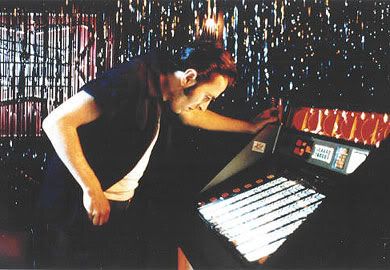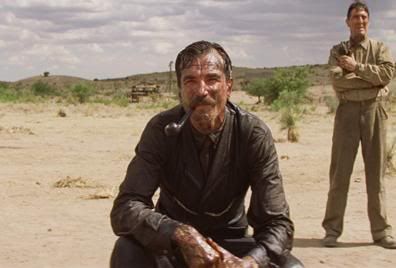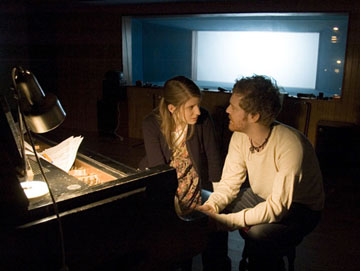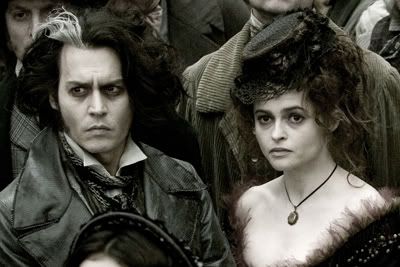 “I like playing with things happening at the same time and characters being in the same place, but not interacting and yet being somehow connected by some little threads.”
“I like playing with things happening at the same time and characters being in the same place, but not interacting and yet being somehow connected by some little threads.” –Jim Jarmusch
Jim Jarmusch followed up his first two films,
Stranger Than Paradise and
Down By Law, with his first color feature,
Mystery Train. Like
Stranger and
Down By Law, Mystery Train involves nomadic characters that don’t seem to fit in with mainstream society. The film also contains a lot of natural and irrelevant dialogue exchanges many of which involve pop culture. In terms of style, however, Jarmusch seems to be expanding on techniques he employed in his previous films. For example, the tracking shot of Eva walking along the streets of New York in the opening sequence of
Stranger becomes a staple cinematographic technique in
Mystery Train as it not only illustrates the characters’ relationship to their environment but, through repetition, also helps strengthen the characters’ relationships to one another. The most obvious expansion is Jarmusch’s decision to shoot the film in color. Because Jarmusch has a predilection for black and white cinematography, his decision to use color is important and certainly not trivial or accidental. Its significance is something to be examined in relation to other areas of the film.
Mystery Train is a clear departure from Jarmusch’s first films in that it involves a more complex narrative structure. Jarmusch described his intent for the film as “episodic but simultaneous” which is exactly what
Mystery Train is at face value. There are three episodes in the film and through a variety of cues it becomes apparent that the episodes are occurring simultaneously. What is most interesting about
Mystery Train is that all three episodes are rich enough to stand on their own, yet the subtle connections between each of them breathe new life into the three storylines as they play out. Through color, mise-en-scene, sound, and editing, Jim Jarmusch is able to create important associations between characters in different episodes while still making certain that each episode maintains its own unique qualities.
Color Jim Jarmusch often defends his decision to shoot in black and white or in color based on how he envisions the film in his own mind. Because
Mystery Train functions on a variety of levels, one could argue that the film would work just as well if it were not in color. While that may be true, color serves a particular purpose that actually enhances the unique relationships the characters share in the film.
The color red is particularly noteworthy in
Mystery Train. In making observations, it is impossible not to jot down the variety of red objects that appear throughout the film. The color red can be interpreted in a number of ways especially in the context of this particular narrative. One could argue that red reflects the distinct emotions the characters of each episode evoke. For example, the red lipstick in shot 55 between Mitzuko and Jun suggests a kind of passion and sexuality but it is a subtle suggestion simply because it is difficult to define what kind of relationship Mitzuko and Jun have and how exactly they feel about one another.
The red truck that appears most prominently in shots 197-212 when Johnny, Charlie, and Will drive around Memphis is another example of complicated symbolism. In this case, red seems to symbolize danger and impulsiveness as Johnny has just held up a liquor store and the three of them have proceeded to flee the scene. Just as with the red lipstick, however, perhaps what the red truck symbolizes is not as simple as it appears at face value. While Johnny did act impulsively and he, Charlie and Will did get themselves involved in a dangerous situation, the sequence where the three of them flee the scene of the crime, drive around and drink the liquor is rather comical in its minimalism. They don’t talk to one another, after awhile they seem completely unfazed by what has happened, and there is not the least bit of tension or hostility as they proceed to get more intoxicated and less coherent with every shot. Jarmusch has made a career out of offering his audience an alternative to mainstream Hollywood film devices and his ambiguous and often ironic use of color in
Mystery Train is no exception.
Color, like the narrative of the film, also unifies characters. In each episode, one could argue that there is at least one red object that ties the characters together in a unique way. The most obvious example is the red suitcase Mitzuko and Jun carry around Memphis. A bamboo pole is attached to the suitcase which they use to carry the suitcase between them. The suitcase obviously brings them together in this way but it also provides a moment of conflict between them. This moment occurs when Jun wants to pack a few hotel towels but is unable to fit them in because Mitzuko has bought too many t-shirts. They quickly compromise as Mitzuko proceeds to put on several of the shirts to free up some room and Jun agrees to only pack one of the towels. The suitcase again unites them as they both work together to close it before leaving the hotel.
In the second episode, Luisa carries a red purse. While she and Dee Dee are packing up and getting ready to leave the room they shared together, Dee Dee inquires about the money situation. Luisa takes two hundred dollars from her purse which she then gives to Dee Dee freely. This is another instance of a red object representing an act of camaraderie or generosity.
Finally, there is the red truck in the third episode. Johnny, Charlie, and Will have a bonding experience of sorts in the truck after Johnny sticks up the liquor store. At first it seems as though Charlie is on the outside as he refuses to partake in the drinking. However, as the sequence plays out, instead of passing the bottle back and forth Charlie finally takes a drink. Despite Charlie’s best efforts to distance himself from the illegal activities of Johnny and Will, he eventually succumbs and all three men find themselves on a par with one another by the time they reach the hotel. After Charlie is shot, Will and Johnny help him into the back of the truck before fleeing again in the morning. The red truck has not only united these three characters but it also serves as the device that allows them to help one another out.
Mise-en-Scene A lot of
Mystery Train occurs in the Arcade Hotel and several aspects of the mise-en-scene help connect characters and contribute to the general narrative cohesion of the film. What is interesting is how the mise-en-scene repeats itself across the first two episodes but then subtly varies itself in the third episode. In Mitzuko and Jun’s hotel room, there is the radio chained to the nightstand and an Elvis painting on the wall. In Luisa and Dee Dee’s room there is also the radio chained to the nightstand and an Elvis painting on the wall. While this repetition is not surprising because hotel rooms are supposed to look like one another, it becomes comical when Johnny, Charlie and Will enter their room. The night clerk has appropriately given them the rundown “Room 22” as they themselves are bedraggled and falling apart. The painting of Elvis is not hanging but leaning against the nightstand. The frame of the painting is dislodged from the painting itself. On the nightstand there is also a loose chain hanging freely where the radio should be attached. It is as though the radio has been stolen by some previous delinquent guest and never replaced. Because the audience has seen the chained radio in the first two episodes, the sight of the loose chain is not a mysterious one. However, Charlie, drunk and clueless, looks at the chain with total confusion and inquires why it is there. Will responds, “That’s cause you’re in the kinky sex room.” Will’s response is amusing in its randomness, yet it takes on an even more humorous quality because the audience knows something that Will does not and that is due to the knowledge we have gained from earlier episodes.
Another amusing incident relating to the mise-en-scene has to do with the Elvis painting. The figure of Elvis is a recurring theme in
Mystery Train as he is either scoffed at or idolized by different characters throughout. To the women, Elvis represents a godlike icon (Mitzuko), an angelic ghost (Luisa), or a foolish lover (Dee Dee). In other words, there is a longing and intrigue that oozes from the female characters when they encounter their own personal version of Elvis. The male characters are just the opposite. Jun is completely unaffected by Elvis and continuously tries to debate how Carl Perkins is in fact the real king of rock and roll. Johnny cannot stand the fact that his friends call him Elvis and ironically asks to be called Carl Perkins, Jr. instead. Relating this particular discrepancy about Elvis back to the mise-en-scene, the reaction Johnny has to the Elvis painting in the hotel room takes on a whole new meaning when compared to how the painting fits into previous scenes. Mitzuko stares up at the painting in her hotel room with awe and admiration and the painting in Luisa and Dee Dee’s room inspires Dee Dee to divulge with some fondness the details of her sordid relationship with a man people called Elvis. That man, who actually turns out to be Johnny, has an altogether different reaction to the painting. He recoils at the sight of it and says with disgust, “I can’t get rid of that fucking guy.” The moment is a hilarious one but more importantly it reduces this mystical and untouchable concept of Elvis established by the women in earlier scenes to exactly what it has become in this scene: an old, crooked, and decaying picture in a dilapidated room of a rundown hotel.
Sound Sound is undeniably the most powerful unifying device in
Mystery Train. Several different elements of sound help the viewer make sense of the narrative structure of the film as characters hear the same sounds from different locations, and this indicates that certain scenes are, in fact, occurring simultaneously. As with other stylistic techniques in the film, Jarmusch establishes a repetition and variation pattern with his sound design. The three main sound devices that connect the three episodes of the film are a radio DJ bit followed by Elvis’s “Blue Moon,” a train passing by near the hotel, and a gunshot. The sounds occur similarly in the first two episodes but they are given new meaning when presented in the third and final episode.
The three sounds occur in a somewhat similar fashion in “Far From Yokohama” and “A Ghost.” Mitzuko and Jun are in bed when “Blue Moon” comes on the radio in their room. (Shot 70) Luisa and Dee Dee are also in bed when “Blue Moon” comes on the radio in their room. (Shot 157) Jun is standing next to the window and talking to Mitzuko who is lying in bed (61) and the sound of a train can be heard off screen. This is followed by an extreme long shot (62) of the train moving along a track just above an empty street. There is also a shot of Dee Dee standing next to the window talking to Luisa who is lying in bed (153) and the train can be heard off screen. This is followed by the same extreme long shot (154) of the train.
“Lost in Space” incorporates these sounds in a different way so that the third episode becomes variation on the sound design established in the first two episodes. Johnny, Charlie, and Will do not hear “Blue Moon” in their hotel but in their truck as they drive around trying to find a hideout. This shot of them listening to “Blue Moon” in the truck actually follows a shot of Will’s truck driving down the street and below the passing train from shots 62 and 154. The sound and subsequent extreme long shot of the train is repeated here but the sound and image of the train become something different because Johnny, Charlie, and Will have now integrated themselves into the shot.
This repetition and variation occur once again with the sound of the gunshot. In both shot 74 and shot 176, the gunshot is heard when the characters are packing and getting ready to leave the hotel. Sound is again expanded upon in the third episode as the source of the gunshot is revealed. In shot 245, after Charlie struggles to wrestle a gun out of Johnny’s hands, the gun accidentally goes off causing the sound of a gunshot.
Editing: Repetition of Shots Because the narrative of
Mystery Train is a complex one, editing plays an integral role. While it eventually becomes evident that each episode is occurring simultaneously, there is very little in the film that is actually repeated. Characters from individual episodes do not run into one another as their scenes are being played out. The only real cues to the simultaneity of the film have to do with sound.
There is, however, one scene that does occur in one form or the other in each of the three episodes. The scene is played out for the first time in its entirety in shot 71 and it involves the bellboy putting on a pair of sunglasses followed by a conversation between him and the night clerk about fashion. The scene ends with the clerk making fun of the bellboy’s hat. It is clear that this scene occurs in real time right after the one in which Mitzuko and Jun are lying together post-coital because the song “Blue Moon” bridges the two scenes. There is a fade-out following shot 71 and then a fade-in precedes the next shot of Mitzuko and Jun waking up in the morning.
This sequence structure repeats itself in shots 171-173. Shot 171 shows Luisa still in awe of the Elvis ghost she has just seen. This is followed by a shot of the bellboy putting on the sunglasses. However, this time the shot is cut off before the bellboy takes off the sunglasses and he and the night clerk have the conversation about fashion. Again there is a fade-out and fade-in from shot 172 to 173 and shot 173 reveals Dee Dee waking up in the morning. If the technique employed in shots 171-173 is a repetition on that employed in shots 70-72, then shots 213-214 are a variation on that technique.
Shot 213 picks up where shot 172 left off. The bellboy takes off the sunglasses and he and the night clerk have the fashion conversation. Instead of having this scene cut off again like in 71, the scene continues to play out as a “Jiffy Squid” commercial comes on the radio following “Blue Moon” causing the clerk to recoil in horror and consequently turn off the radio. Following this shot is one of Will, Charlie, and Johnny arriving at the hotel. Because it has now become evident that the men’s arrival immediately followed the fashion conversation between the bellboy and the night clerk, it also becomes evident why only bits and pieces of the scene were played out in the previous two episodes. Through this technique, Jarmusch has somehow connected all three episodes with one similar shot while simultaneously avoiding having episodes bleed into one another.
With
Mystery Train, Jarmusch has created three uniquely brilliant vignettes about relationships and the strange yet beautiful way people communicate with one another. While it is a clear departure both stylistically and narratively from his earlier work, Jarmusch has not abandoned his love of the little things.
Mystery Train contains so many tiny details that it would take several viewings of the film to discover all of them and truly appreciate their importance. This quality that Jarmusch’s films possess is an important one because if his films continue to be watched, the characters and the worlds he creates continue to exist as well. Jarmusch has an undeniable ability to instill in his audience a desire to give his films a closer look, and it is precisely this ability that makes Jarmusch one of the most important American independent filmmaker of his time.








